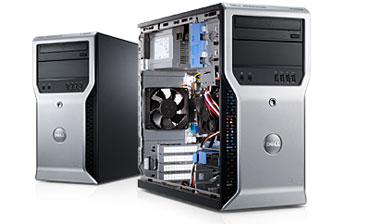Review: Dell's Updated Entry-Level Workstation

At around this time last year, the CRN Test Center characterized "Dell's T1500 entry-level workstation models a good thing in a small package."
The updated T1600 systems are even better. They now offer greater processor options, include ISV certifications, while pricing has not increased significantly.
The Precision T1600 Dell sent the Test Center for review was equipped with an Intel Xeon E31270 quad-core processor at 3.4 GHz, Intel C206 chipset, 64-bit Windows 7 Professional running on 8 GB of DDR3 1333Hz ECC memory. Other options included an NVIDIA Quadro 2000 dual-monitor video board with 1 GB video RAM, and dual 500GB 7200RPM SATA drives configured in a RAID 0 array.
Like its T1500 predecessor, the T1600 boots quickly, taking less than a minute to go from fully off to ready for action. It wakes from sleep in about three seconds. Also impressive in terms of system performance, the T1600 turned in a Geekbench 2.2 score of 14,891, knocking the T1500 to second place on our list of all-time production PC performers. The T1500 we tested was built around the Intel Core i7 quad-core part, and scored 9,286.
In separate tests we've done, the CRN Test Center has been impressed with the performance of NVIDIA's Quadro 2000, particularly with work involving CAD, scientific visualization workloads and when rendering models with millions of vertexes. When measuring video performance using Standard Performance Evaluation Corp.'s Viewperf 11, the Precision T1600 handled video rendering as well as or slightly better than any testbed machine we've seen.
At about 17 x 14.5 x 6.5 inches, the Precision's handsome silver and black mini-tower case is compact enough to fit in or under a desk cabinet, yet is still fairly expandable. Its two internal 3.5-inch bays can handle up to four 2.5-inch drives (or a pair of 3.5-inch drives). One of the two external 5.25-inch bays was occupied by a DVD-RW drive. The motherboard supports two SATA 6Gbps and two SATA 3Gbps drives.
Servicing the system's innards got easier since the T1500. Replacing the older model's thumbscrews is a single latch that allows the lockable side panel to be removed without screws. No tools are needed inside either, thanks to plastic spring-clip mounting rails for the internal drives and spring-loaded locking mechanisms for external drives and expansion cards.
The system offers three PCIe expansion slots -- one each for x16, x4 and x1, and a legacy PCI slot. The Dell micro-ATX motherboard can address 16GB ECC memory or 6GB of non-ECC memory through four SIMM slots. The power supply is affixed with the usual four screws, accessible from the rear. The tested unit was equipped with the stock 265-watt unit, which Dell says is 65 percent efficient. For the energy conscious, the company offers a 320-watt unit that's rated at 90 percent efficiency.
The T1600 offers a total of 10 USB 2.0 ports (four front, six rear). Option cards are available to add two USB 3.0 or a FireWire port. The rear panel presents serial, VGA, PS/2, DisplayPort and gigabit Ethernet ports. Headphone and microphone jacks are on the front panel.
For builders of white-box desktop systems, Dell's Precision line offers a convenient platform for provisioning made-to-order workstations with AMD or Intel Core or Xeon processors starting at around $629 retail. The Precision T1600 delivered excellent performance, generous options and a small footprint. That's why the Precision T1600 is a CRN Test Center recommended product.